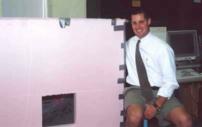 Rory . . . |
 . . . and "The Cube" |
Scaling Properties Of Light Transmission
In A Simulated Cloud
Rory Caster '00
Abstract:
The spatial distribution of liquid water in clouds has a major effect on how much light is transmitted to the earth. Upon viewing a cloud from the ground one may think that the water drops in that cloud are just floating around in a random, independent motion. If the water drops were evenly spaced throughout, then on an overcast day the amount of light transmitted would be low leaving us with a much darker daytime. In actuality the drops exhibit a clumping property that permits light to be transmitted through the less dense regions of the cloud. I am continuing a project that was attempted last year where we simulate a cloud in a 1 m3 box using small polystyrene beads that will represent water drops. A leaf blower is used to blow around the beads, which recreates the random, turbulent motion present in real clouds. A laser beam is then sent through the simulated cloud and gets detected by a sensor. The transmission of light will fluctuate a great deal as the beads are sent across the path of the laser. By studying these fluctuations we hope to discover what the scaling properties of the system might be. Preliminary analysis of the histograms shows that the beads are not independent of each other, leaving us with the possibility that a clumping effect does occur.
For more information, contact Dr. Brian Watson:
|
|
||
| © | St. Lawrence University | Department of Physics |
| Revised: 25 Jun 03 | Canton, NY 13617 |